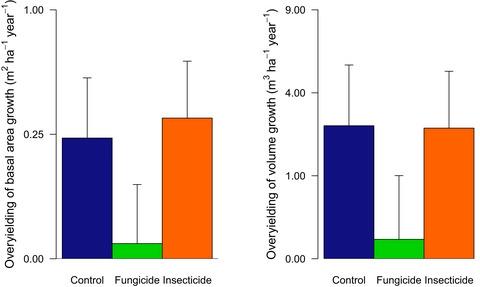Journal of Ecology ( IF 5.3 ) Pub Date : 2022-06-02 , DOI: 10.1111/1365-2745.13940 Yuanyuan Huang 1, 2, 3 , Andreas Schuldt 4 , Lydia Hönig 5 , Bo Yang 6 , Xiaojuan Liu 7 , Helge Bruelheide 2, 5 , Keping Ma 7 , Bernhard Schmid 1, 8, 9 , Pascal A Niklaus 1

|
1 INTRODUCTION
The biological mechanisms that drive beneficial effects of species richness on primary productivity (e.g. Hooper et al., 2012; O'Connor et al., 2017; Tilman et al., 2001) are not well understood, despite decades of research. It is clear that species diversity effects ultimately depend on some form of functional complementarity among species, but which niche dimensions underpin this complementarity, and in which functional traits these niche differences manifest themselves, remains elusive (Flynn et al., 2011; Loreau, 2000; Paine et al., 2015; Van der Plas et al., 2020). It has been proposed that complementary resource use results from spatial, temporal, or other forms of resource partitioning among species, and that this then translates into a more efficient or more complete resource use in more diverse plant communities, and therefore into a higher productivity (Loreau et al., 2001; Turnbull et al., 2016). However, surprisingly little evidence exists to date about which resources are partitioned and through which actual biological mechanisms this occurs (Barry et al., 2019; Silvertown et al., 1999; von Felten et al., 2012). An important (but also long-known) exception are ecosystems that contain species associated with symbiotic nitrogen fixers such as rhizobia. Through this symbiosis, legume species in grassland increase their own nitrogen supply, and eventually also the amount of nitrogen availability to non-legumes in the community, and productivity increases (Spehn et al., 2002). Apart from this special case, however, it is still unclear how important and general the partitioning of abiotic resources really is in promoting biodiversity–productivity relationships.
Generalized niche concepts encompass dimensions other than abiotic resources, including shared enemies (Chase & Leibold, 2003). Recent studies indeed suggest that interspecific complementarity of biotic interactions, in particular with pathogens and consumers, may underpin positive BEF-relationships (Guerrero-Ramírez & Eisenhauer, 2017; Liu et al., 2012; Maron et al., 2011; Mommer et al., 2018; Poisot et al., 2013; Schnitzer et al., 2011, 2011; Wang et al., 2019) (but also with beneficial organisms, see Yang et al., 2021). Enemies often show some degree of host-specificity, and the reduction in enemy populations at the lower host densities in more diverse plant communities may therefore reduce negative feedback from these enemies and thereby increase plant productivity. Overall, this then manifests as a negative density-dependence of host growth (Keesing et al., 2006).
Low-latitude forests exhibit a high plant species diversity and often show high herbivory rates and pathogen load (Bagchi et al., 2014; Novotny et al., 2006; Schemske et al., 2009). In these forests, enemies may therefore be important modulators of community-level productivity (Bagchi et al., 2014), and niche differentiation among species with respect to pathogen and consumer interactions may support BEF-effects (Guyot et al., 2016; Jactel & Brockerhoff, 2007; Vehviläinen et al., 2007). However, a higher diversity of trees may also lead to a shift from specialist to generalist herbivores and pathogens, or promote populations of these enemies through dietary mixing and habitat improvement through environmental heterogeneity (Brezzi et al., 2017; Castagneyrol et al., 2012; Schuldt et al., 2010). This could weaken diversity–productivity relationships.
To test whether interactions with enemies modify diversity-productivity relationships in tree communities, we combined insecticide and fungicide application with tree species richness treatments in a large-scale forest biodiversity experiment in subtropical China (Bruelheide et al., 2014; Huang et al., 2018). The experimental plots contained 1 to 16 tree species that had been growing for 6–7 years and reached an average height of approximately 3 m when the pesticide treatments were applied to subplots for an additional 2 years. We monitored tree growth in pesticide-treated and control plots, and measured leaf damage in additional control plots. We then tested whether diversity–productivity relationships were modulated by the suppression of insects and fungi by experimental pesticide application. We further investigated the species-level responses to these treatments, and their dependencies on species traits. Specifically, we predicted that the suppression of enemy-mediated impacts by pesticides would dampen BEF relationships because these were at least partially mediated by density-dependent effects of enemies.











































 京公网安备 11010802027423号
京公网安备 11010802027423号